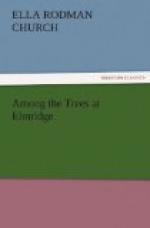On hearing of these drawbacks the children soon decided that their own dear home was the best, and no longer envied the possessors even of the cow tree.
CHAPTER XIV.
HOME AND ABROAD: LINDEN, CAMPHOR, BEECH.
“Now,” said Miss Harson to her expectant flock, “it is to be hoped that our foreign wanderings among such wonderful trees have not spoiled you for home trees, as there are still a number of them which we have not yet examined.”
“No indeed!” they assured her; “they liked to hear about them all, and they were going to try and remember everything she told them about the trees.”
Their governess said that would be too much to expect, and if they remembered the most important things she would be quite satisfied,
“We will take the linden, lime, or basswood, tree—for it has all three of these names—this evening,” she continued, “and there are nine or ten species of the tree, which are found in America, Europe and Western Asia. It is a very handsome, regular-looking tree with rich, thick masses of foliage that make a deep shade. The leaves are heart-shaped and very finely veined, have sharply-serrated edges and are four or five inches long. The leaf-stalk is half the length of the leaf. It blooms in July and August, and the flowers are yellowish white and very fragrant; when an avenue of limes is in blossom, the whole atmosphere is filled with a delightful perfume which can hardly be described.”
[Illustration: THE LINDEN OR LIME TREE (Tilia).]
“There are no lime trees here, are there?” asked Clara.
“No,” was the reply, “I do not think there are any in this neighborhood; but they grow abundantly not many miles away. Our native trees are not so pretty as the English lime, which, clothed with softer foliage, has a smaller leaf and a neater and more elegant spray. Ours bears larger and more conspicuous flowers, in heavier clusters, but of inferior sweetness. Both species are remarkable for their size and longevity. The young leaves of the lime are of a bright fresh tint that contrasts strongly with the very dark color of the branches; and these branches are so finely divided that their beauty is seen to the greatest advantage when winter has stripped them bare of leaves.
“’The linden has in all ages been celebrated for the fragrance of its flowers and the excellence of the honey made from them. The famous Mount Hybla was covered with lime trees. The aroma from its flowers is like that of mignonette; it perfumes the whole atmosphere, and is perceptible to the inhabitants of all the beehives within a circuit of a mile. The real linden honey is of a greenish color and delicious taste when taken from the hive immediately after the trees have been in blossom, and is often sold for more than the ordinary kind. There is a forest in Lithuania that abounds in lime trees, and here swarms of wild bees live in the hollow trunks and collect their honey from the lime.’”




